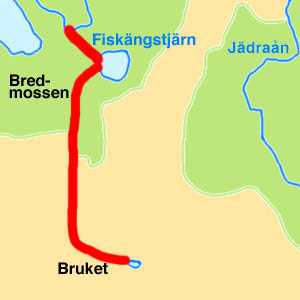Women washing in the canal
Women washing in the canal
The washhouse
People swimming in the canal
Dal-Britta's damm, the end of the canal
One of the canalboats

Women washing in the canal | Women washing in the canal | The washhouse |
People swimming in the canal | Dal-Britta's damm, the end of the canal | One of the canalboats |
It's usually called the Canal.
Kjell Rixon tells us:
I moved from Sandviken in 1959.
This little I know about the canal:
* It was built to supply the iron works with water, but nowadays it lacks economic importance.
* I estimate that it is 5 kilometers long. It comes from Bredmossen (formerly peat digging) and runs to Storsjön.
* There used to be a narrow gauge railroad by the canal. The trains transported peat to town.
* There were floodgates in the canal.
* There were a lot of crayfish in the canal.
* The canal was used for washing.
* I guess boating was minimal.
Jan-Åke Nässlander remembers the canal from his childhood. He played around the canal in the 1950ies:
"The canal was a great adventure, flowed slowly and majestatically straight through the town centre. We sailed there on rafts, we tried fishing, bathing and experienced enormous adventures . . . on the Nile of Sandviken . . .
Jan-Åke has supplied two clips from books about the canal and the town, that has givven me the facts for the historical text below.
History:
The aim of the canal was to supply the iron works with water. Almost all of the workers at the irons works had to help out and dig at the canal, and at most there were 300 persons digging. The digging started on March 14th 1862.
One exceptional woman worked at the canal. Dal-Britta worked like a real man, and became a living legend in Sandviken.
There were some troubles along the work. On May 1st 1862 all workers went on strike to get better payment. Lieutenant Gustaf Lilliehöök led the works at the canal and agreed to the demands, but he also threatened to kill the man who initiated the strike. That unionleader left town very quick!
The workers had nothing but spades and crowbars to help along so digging was harder then planned. The canal was not finished until late spring, or possibly early summer in 1863 before they could let the water into the canal. During the works there had been frequent landslides along the canalsides. The cost for ther canal had been estimated to 110 000 SEK, but when finished it had cost 200 000 SEK.
The canal was built 3 kilometers long, about 4 meters deep and 15 meters wide.
The company built a washinghouse near the canal were the workers wifes were able to wash their husbands clothes. During summer time they washed in the canal instead at special bridges.
There were a lot of boats at the canal. There were bridges for these boats by the factory. Some passengerboats also used the canal. Best known of those were Näckrosen and Vega. On saturday evenings those boats sailed to different dancepalaces.
There were two places for bathing along the canal. One for boys and one for girls.
This page was modified at